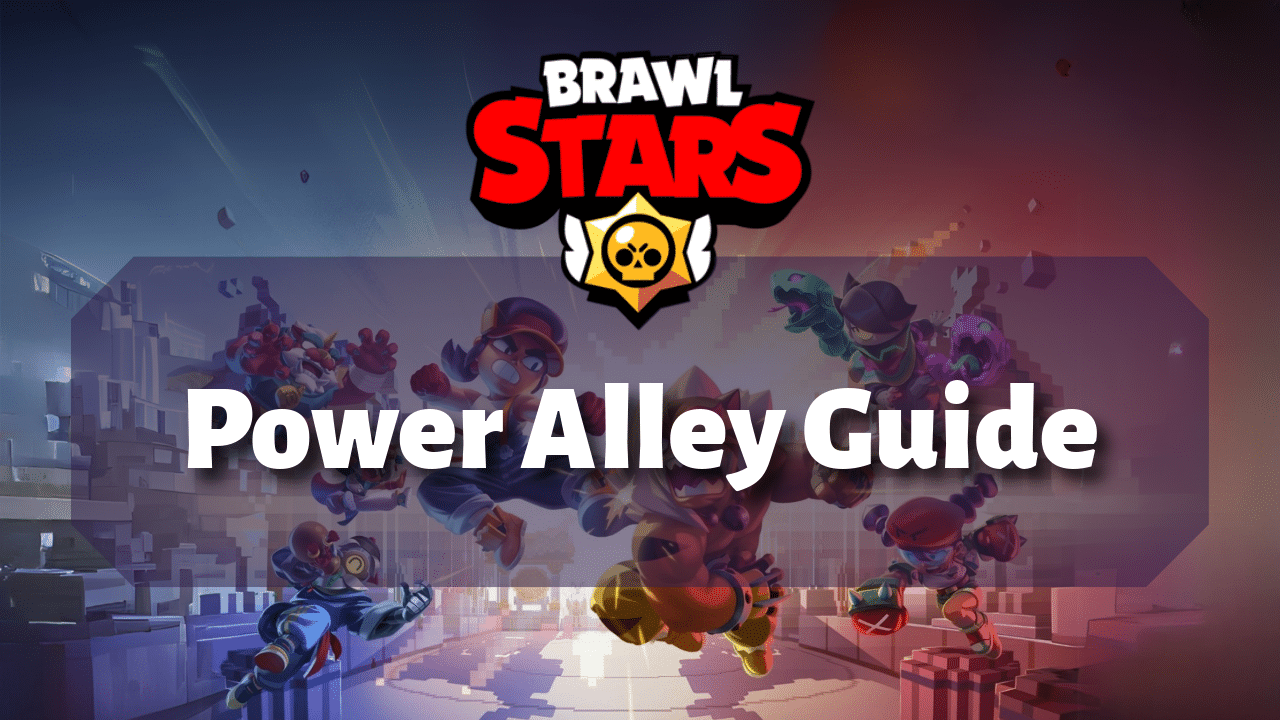
- Brawl Ball Arena
- Arcade Block – 24
- Yellow Box – 8
- Blue Barrel – 8
- Metal Fence – 20
- Bush – 42
Brawl Stars Power Alley Guide: Introduction
Brawl Stars Power Alley is an intense and fast-paced map that demands quick reflexes, smart positioning, and effective teamwork. The narrow layout, combined with strategic cover and choke points, creates a battlefield where engagements happen frequently, and every movement counts. Whether pushing forward aggressively or holding a defensive stance, players must constantly adapt to the fast-changing flow of the match to secure victory.
The Brawl Stars Power Alley map features a mix of tight corridors and open lanes, making it crucial to choose brawlers that can excel in both close-quarters combat and mid-range control. While tankier brawlers can dominate in tight spaces, ranged brawlers can provide support by controlling lanes and dealing chip damage from a distance. Throwers are especially effective due to the many walls that can block enemy movement, allowing them to attack safely from behind cover.
Brawl Stars Power Alley’s high-risk, high-reward nature makes it important for players to coordinate their attacks and control key areas of the map. Holding the middle section is often the key to victory, as it provides the best vantage points for engaging enemies while limiting their movement options. However, flank routes are also available, meaning teams must always be aware of enemy rotations and be ready to reposition when needed.
Success in Brawl Stars Power Alley comes down to smart decision-making, map awareness, and teamwork. Players who can adapt to the terrain, predict enemy movements, and utilize cover effectively will have a significant advantage. Whether you’re looking to overwhelm opponents with aggressive pushes or control the battlefield with precision attacks, mastering Power Alley’s mechanics is essential for securing consistent wins.
Brawl Stars Power Alley Guide: Map Layout and Key Features
Brawl Stars Power Alley is a tight, lane-based map that creates a balance between structured combat zones and opportunities for flanking. The layout consists of three primary lanes separated by walls and obstacles, leading to highly contested engagements as players battle for control of key areas. Unlike more open maps, Power Alley’s confined structure encourages frequent brawls, making aggressive and defensive strategies equally important depending on your playstyle.
The central area serves as the heart of the battlefield, where most clashes take place. Holding this zone provides a strategic advantage, as it allows a team to cut off enemy rotations and control movement across the map. Because of its importance, this area is often heavily contested, and teams must carefully coordinate their movements to prevent being overwhelmed. The mid-lane’s narrow structure makes it an ideal battleground for mid-range and melee-focused brawlers, as they can take cover behind walls while applying pressure on enemies attempting to push forward.
On either side of the Brawl Stars Power Alley map, flanking routes offer alternative paths for more strategic plays. These side lanes allow assassins, fast-moving brawlers, or tanks to sneak around opponents and disrupt enemy formations. However, these routes come with risks—without proper scouting or control, players can easily walk into ambushes or find themselves trapped against an enemy team. Controlling both the mid and side lanes effectively can give a team the upper hand, allowing them to apply pressure from multiple angles and force opponents into difficult positions.
The Brawl Stars Power Alley map’s natural choke points make area-of-effect attacks, crowd control abilities, and burst damage extremely valuable. Walls provide crucial cover, allowing throwers like Barley and Dynamike to attack from behind obstacles, while long-range brawlers like Piper or Brock can take advantage of open lanes to apply pressure from a distance. Since mobility and positioning are key, choosing the right mix of brawlers is essential for holding territory, executing flanks, and countering enemy advances.
Brawl Stars Power Alley Guide: Choosing the Right Brawlers
Selecting the right brawlers for Brawl Stars Power Alley is essential for gaining control over key areas, maintaining pressure, and securing eliminations. Given the map’s narrow lanes, walls, and choke points, different types of brawlers shine in specific roles. A well-balanced team will consist of close-range brawlers for front-line pressure, mid-range brawlers for sustained damage, long-range brawlers for support, and throwers for area denial. Understanding how each type of brawler functions on Power Alley will help you adapt your strategy and counter enemy teams effectively.
Close-Range Fighters for Brawl Control
Since Brawl Stars Power Alley is designed with tight corridors and enclosed areas, tanky brawlers with high health and burst damage dominate in close combat. Brawlers like Rosa, Bull and Ash are excellent choices, as they can push aggressively and hold down key positions without being easily eliminated. Their high survivability allows them to stay in fights longer, forcing enemies out of cover and controlling choke points effectively. Tanks are also great for absorbing damage while distracting enemies, giving teammates opportunities to reposition and take control of the map.
Mid-Range and Control Brawlers
Brawlers with medium-range attacks and consistent damage output are crucial for holding lanes and keeping enemies in check. Fighters like Bea, Spike, and Buster excel in Brawl Stars Power Alley’s confined spaces because they have enough range to apply pressure while still being effective in close combat when needed. These brawlers play a key role in controlling choke points, as they can poke enemies from a safe distance while still having the firepower to eliminate targets up close. Their versatility makes them valuable assets for both offense and defense, ensuring that enemies struggle to advance without taking heavy damage.
Long-Range Support
Although Brawl Stars Power Alley primarily favors close-quarters combat, long-range brawlers like Belle and Brock can still be viable when played carefully. Their ability to snipe enemies from open lanes and apply pressure from a distance is extremely useful for supporting teammates and keeping enemies from advancing too aggressively. However, long-range brawlers must be played with caution—tanks and assassins can easily close the gap, making positioning crucial. Staying near walls, teammates, or escape routes will ensure they don’t get caught off guard.
Throwers and Area Control
Throwers such as Dynamike and Barley thrive in Brawl Stars Power Alley because of its numerous walls and obstacles, which provide cover while allowing them to attack enemies indirectly. Their ability to lob attacks over walls makes them excellent for controlling narrow passageways, denying enemy movement, and forcing opponents out of cover. A well-placed Barley super or Dynamike’s burst damage can lock down choke points, making it difficult for the enemy team to push forward. However, since throwers are generally low-health and lack mobility, they must position themselves carefully and avoid getting caught in open areas where enemies can easily rush them.
Understanding the strengths and weaknesses of different brawlers in Brawl Stars Power Alley is key to developing a solid strategy and countering enemy tactics. Whether using tanks to control choke points, mid-range brawlers to maintain pressure, long-range fighters for support, or throwers for area denial, each role plays an essential part in securing victory. By balancing your team composition and playing to each brawler’s strengths, you can effectively outmaneuver opponents and dominate the battlefield.
Brawl Stars Power Alley Guide: Best Game Modes
Brawl Stars Power Alley’s tight corridors and narrow lanes create an intense battleground that rewards strategic positioning and coordinated teamwork. Some game modes shine more than others due to the layout’s chokepoints and close-quarters combat. The combination of confined spaces and limited escape routes makes every decision crucial, emphasizing the need for precise movement and tactical plays. Understanding how to take advantage of Power Alley’s terrain will give teams an edge in competitive play. Below are some of the best game modes for this map.
Brawl Ball
Brawl Ball on Brawl Stars Power Alley is a fast-paced, high-pressure mode where tight spaces and narrow lanes make advancing the ball a challenge. Teams must clear defenders before making a push, using tanks like Bull and Rosa to break walls and create openings while mid-range brawlers like Spike and Buster provide control. Positioning is key, as losing the ball in a bad spot can quickly turn the match. Controlling chokepoints, passing efficiently, and using Supers wisely to break obstacles or disrupt opponents are essential for securing a goal.
Volley Brawl
Volley Brawl on Brawl Stars Power Alley is a test of precision and positioning, as the tight barriers and limited movement space make reacting to the ball’s landing spot more difficult. Teams must anticipate its drop and block opponents from reaching key zones. High-mobility brawlers like Max and Fang excel at repositioning quickly, while tanks like Frank and Ash can hold their ground and disrupt enemy movement. Controlling space is crucial, making area-denial brawlers like Spike or Barley valuable assets. Quick reactions and strong coordination are essential, as a single misstep can turn the tide of the match.
Brawl Stars Power Alley is a map that demands adaptability, strong positioning, and smart decision-making in every match. Whether it’s setting up goals in Brawl Ball or controlling space in Volley Brawl, success comes from understanding how to navigate the terrain effectively. The narrow lanes and chokepoints create a dynamic battleground where teams must react quickly to changes in positioning and enemy movements. Teams that communicate well and leverage the map’s natural chokepoints will have a clear advantage. Mastering the flow of battle and knowing when to push aggressively or hold back is the key to dominating on Power Alley.
Brawl Stars Power Alley Guide: Tips and Tricks
Brawl Stars Power Alley is a fast-paced and strategic map that rewards players who can control space effectively while adapting to its narrow pathways and choke points. The tight layout makes every movement and engagement crucial, as one mistake can quickly lead to a disadvantage. Whether playing aggressively or defensively, understanding how to use cover, maintain positioning, and counter flanking attempts is essential for success. Teams that work together to control the middle and anticipate enemy movements will have the upper hand in most engagements. Proper communication and coordination can make a huge difference, ensuring that teammates capitalize on openings and prevent enemies from taking control of key areas.
⭐ Control the Middle – Most engagements take place in the central area, so maintaining control here can dictate the match’s pace. Holding the mid prevents the enemy from making aggressive plays and allows your team to react more effectively. Controlling this zone also provides easier access to both offensive and defensive strategies, allowing for quicker rotations and safer retreats when needed.
⭐ Use Walls for Cover – The Brawl Stars Power Alley map’s obstacles are crucial for both offense and defense. Use them to block enemy attacks and reposition safely during fights. Proper use of cover can help you survive longer and pressure opponents more effectively. Tanks and throwers benefit greatly from these walls, as they can either shield themselves from ranged attacks or lob projectiles over barriers to control key areas.
⭐ Be Aware of Side Lanes – Flanking is common on Brawl Stars Power Alley map, so always keep an eye on the side pathways to avoid surprise attacks from sneaky opponents. Cutting off enemy flanks can prevent ambushes and keep your team in control. Players who neglect the side lanes risk getting caught off guard, which can lead to losing crucial ground or getting eliminated unexpectedly. Keeping vision and pressure on these routes will ensure your team remains in control of the battlefield.
⭐ Pair the Right Brawlers – A balanced team with a mix of tanks, mid-range attackers, and area control brawlers will be much more effective than a team of only one type. Tanks can push forward and create space, mid-range brawlers can maintain pressure while dealing consistent damage, and throwers or control brawlers can lock down key areas to keep enemies at bay. Having a well-rounded composition increases adaptability, allowing your team to respond effectively to different strategies.
⭐ Don’t Overextend – Since the Brawl Stars Power Alley map has narrow escape routes, overextending without support can lead to getting trapped and eliminated quickly. Always ensure you have an escape plan before committing to an engagement, and rely on teammates for backup when needed. Playing too aggressively without proper support can result in unnecessary deaths, giving the enemy an advantage. Instead, focus on coordinated pushes and defensive retreats to maintain team control over the map.
Mastering Brawl Stars Power Alley requires patience, smart positioning, and strong teamwork. The narrow structure of the map rewards those who play with awareness and coordination, while punishing reckless movement and poor decision-making. Players who can effectively use cover, control space, and anticipate enemy movements will gain the upper hand in every match. With the right strategy and brawler composition, this map can be an exciting battleground for both aggressive and defensive playstyles. Consistently adapting to your opponents and learning from each match will help you turn Power Alley into a map where your team dominates.
Brawl Stars Power Alley Guide: Conclusion
Brawl Stars Power Alley is a high-intensity map that demands quick thinking, strategic positioning, and strong teamwork. Its narrow corridors and limited escape routes make every movement critical, forcing players to carefully plan their attacks and defensive plays. Controlling space effectively is essential, as teams that dominate key choke points and hold advantageous positions will have a significant upper hand. The combination of close-quarters combat and tight lanes creates a dynamic battlefield where aggressive pushes, calculated retreats, and well-timed engagements determine the outcome of each match.
Success on Brawl Stars Power Alley depends not just on individual skill but also on team composition and coordination. A well-balanced team—consisting of tanks to push through enemies, mid-range brawlers to apply steady pressure, and area-control specialists to deny movement—will be much more effective than a group relying solely on one playstyle. Players must also recognize when to advance and when to retreat, as overextending without proper support can quickly lead to getting trapped and eliminated. Learning to use the map’s walls and cover for protection while anticipating enemy movement is key to staying ahead.
Although Brawl Stars Power Alley favors brawlers who excel in close-quarters combat, it also provides opportunities for long-range and thrower brawlers to shine when played strategically. Controlling key choke points and locking down pathways with explosive or lobbed attacks can significantly impact the enemy team’s movement and ability to push forward. Skilled snipers and throwers can zone out opponents, making it difficult for them to approach without taking damage, while brawlers with knockback abilities can capitalize on the map’s tight spaces to disrupt enemy formations.
Whether you prefer to play aggressively and overwhelm opponents or take a more defensive approach by controlling space and denying movement, mastering Brawl Stars Power Alley’s unique layout will give you a significant edge. Understanding when to engage, how to reposition safely, and how to capitalize on enemy mistakes will set you apart from the competition. With practice and teamwork, Power Alley can become one of the most rewarding maps to play, offering fast-paced action and exciting, strategic battles.













